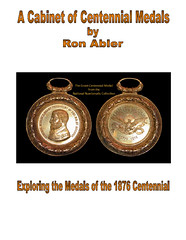
PREV ARTICLE
NEXT ARTICLE
FULL ISSUE
PREV FULL ISSUE
RON ABLER ON THE NUMISMATIC IBOOK
In response to our discussion of tools for numismatic publishers, Ron Abler submitted these thoughts on the iBook. Thanks!
Ron defines an iBook (Internet book) as a cross between a simple website and a traditional paper book.
-Editor
I feel strongly about the concept of an iBook as a publishing format. Unlike an eBook, my iBook is integrated into a website such that it shares the pros (and cons) of a traditional paper book and a interactive dynamic website. Among the advantages of an iBook, as I see them, are: 1. An iBook can be cost-effectively published even when the expected audience is too small to be attractive to traditional publishers (e.g., Whitman, Krause, etc.). My only out-of-pocket costs so far for A Centennial Cabinet have been for the Adobe Acrobat Pro software, plus $100 per year for the web hosting, and $12 per year for the domain name. This does not count the $1,200 for publishing rights to the images of eight medals in the American Numismatic Society collection, because that would have been required for any publishing format. 2. The iBook itself consists of 31 PDF documents, which can be browsed online, or downloaded, saved locally, and browsed offline. They can even be printed for personal use, if desired. 3. The illustrations are almost all in full color and, in most cases, in high enough resolution to be greatly enlarged up to and exceeding full screen size, thus facilitating detailed study as desired. 4. The website itself serves four purposes, not available with other book formats: a. It makes the iBook available to any and all readers without charge (assuming they have Internet access). b. It serves as the navigator through the book, one PDF at a time. c. It provides a Collectors’ Forum for interactive discussion among interested collectors. d. It offers direct email access to the author for questions, suggestions, corrections, and additions. 5. An iBook can be updated as frequently as desired at no additional cost other than labor. This is especially important for a catalog, whose very publication, frozen on paper, guarantees that it will immediately be outdated by the first error noted or the first new addition discovered. The high cost of updating a printed catalog is often too prohibitive to be practical. There are far more first editions than second editions. 6. Even eBooks have high up-front costs, not only for the first edition, but also for subsequent editions. In some cases, such as mine, the up-front cost would probably have been greater than any likely profit from sales. In fact, I was ready to do that when Dave Schenkman convinced me that giving the book away on the web would save me money in the end. It has! 7. Finally, if the demand and the opportunity to publish a traditional physical book arises, I can easily and quickly (relatively speaking, at least) submit the 31 source documents to a publisher. Since an iBook is a compromise, there are, inevitably, some disadvantages: 1. Not all potential readers have convenient Internet access. I hope to offer the entire book (i.e., the PDF documents) on a CD at some cost, with the understanding that the version on the CD will only be the latest version at the time of creation. Of course, this would still require a computer. I am also considering offering the book, printed (and bound if desired) at a copy shop and then mailed, upon prepaid order – no computer required. The iBook itself will continue to be revised as opportunity provides. 2. Some of the PDF files are quite large and do take some time to download. This is a function of my hosting website (faster sites are available at higher cost), as well as the reader’s Internet connection and computer speed. One solution would be to save the downloaded files and browse them locally. The files can then be updated as desired with later downloads. 3. In order to take advantage of Adobe Reader’s page-down feature, each medal in the iBook begins on a new page. This increases the total number of pages. If the book ever goes to a paper publisher, those pages will be closed up. 4. The iBook currently lacks an index. This will make a worthy addition if I can figure out how to do it, given the dynamic nature of an iBook. In the meantime, electronic search is limited to that available within a PDF. All in all, I’m happy with an iBook. It’s not for everyone, and it’s not for every book, but it’s certainly right for me.
To read the earlier E-Sylum articles, see:
The Numismatic Bibliomania Society is a non-profit organization promoting numismatic literature. See our web site at coinbooks.org. To submit items for publication in The E-Sylum, write to the Editor at this address: whomren@gmail.com To subscribe go to: https://my.binhost.com/lists/listinfo/esylum All Rights Reserved. NBS Home Page Contact the NBS webmaster 
|
